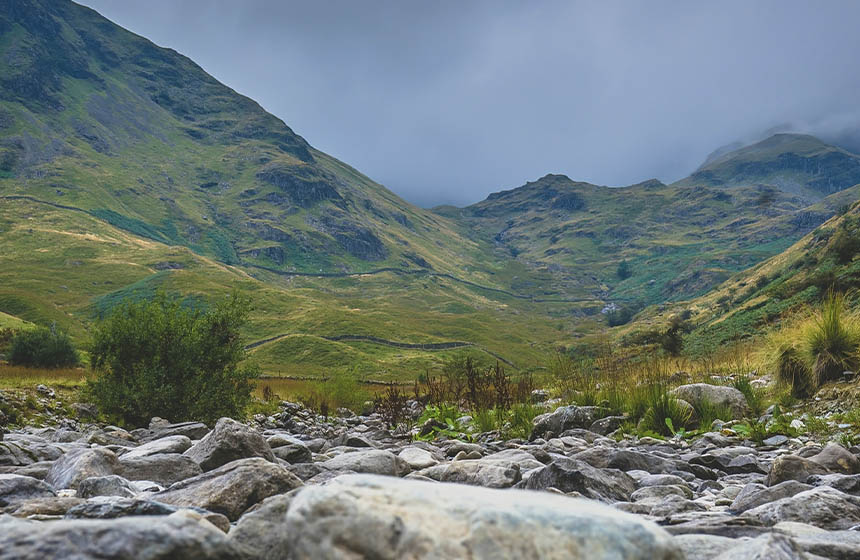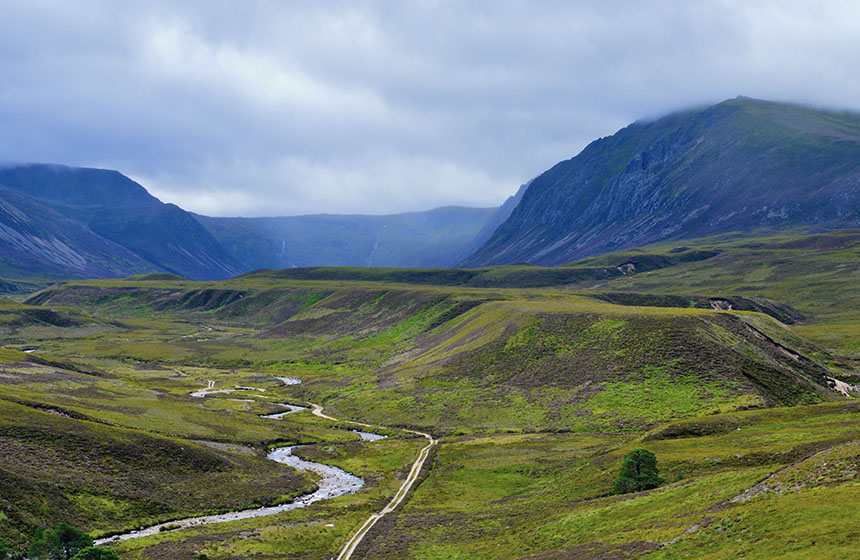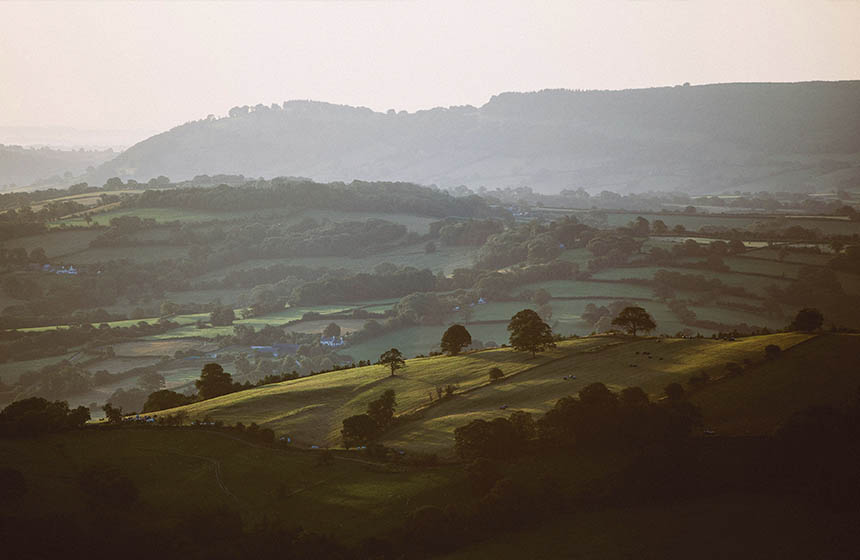Wild Haweswater: sustainable upland hill farming and ecological restoration
Wild Haweswater is a partnership between the RSPB who manage the site and landowner United Utilities. Together, they aim to showcase how sustainable farming techniques can work alongside ecological restoration to improve water quality, enhance biodiversity and benefit people.
Nature-based intervention:
The Naddle and Swindale farms at Haweswater are situated within an upland landscape featuring wildflower meadows, ancient woodlands, peatlands, watercourses, and acidic grasslands. Notably, the Haweswater catchment is identified as a crucial drinking water source for north-west England (1). Historical intensive grazing by sheep and deer on common land has resulted in species poor grasslands and large areas dominated by bracken. Other historical farming practices have similarly altered the landscape, such as peat bog drainage and stream straightening. Since the RSPB started managing the area, farming practices have been altered to reduce and restrict grazing intensity (2). Completed and ongoing interventions include the planting of native trees and wildflowers, naturalisation of straightened watercourses (see separate case study for Swindale Beck), rewetting of peat, enhanced landscape connectivity through the removal of fencing, and the restoration of habitat for the reintroduction of native birds and mammals. Additionally, the project aims to establish sustainable and diversified income streams and engage the community through events and experiences.
Overview of context:
Originally a natural lake, Haweswater was dammed by United Utilities (then Manchester Corporation) to form a reservoir for drinking water supply. In the 1980s, water pollution caused by cattle housing and yard run-off from an upstream farm led to the closure of a stream that feeds into the reservoir, resulting in significant economic impacts due to the loss of water yield (3). The adoption of modified farming practices facilitated the reopening of the intake, underscoring the importance of sustainable farming in this environment. Since 2012, the RSPB has leased two farms in the area and, in collaboration with United Utilities and other partners, is engaged in running a sustainable livestock farm and undertaking landscape-scale ecological restoration.
Case effectiveness on
Climate change
An assessment of 31,433 hectares of land in Cumbria within which Wild Haweswater is situated reports that with efforts to rewet peatlands and establish forests, total net emissions would be reduced by 149,373 tCO2e, displaying significant mitigation potential (4). Within Haweswater, the restoration of peat bogs through the damming of 29 miles of moorland drainage ditches has been attributed to raising the water table and increasing carbon storage in the peat (5). While comparisons between baseline and future levels of carbon sequestration are not publicly available, it is expected that the peatland restoration measures, the planting of around 150,000 native trees across an area of 3000 hectares as of 2019 (6), and the reduced grazing pressure on grasslands can contribute to increases in carbon sequestration across the landscape.
The established tree planting efforts as well as re-meandering of straightened watercourses are purported to enhance natural flood management, increasing catchment resilience to climate change. A study by the University of Leeds found that woodlands in Haweswater reduced rates of streamflow and had more permeable soils compared to sheep pasture (7). This can be beneficial in increasing resilience to climate change induced flooding risks. In other catchment areas in Cumbria, similar results have been modelled where nature-based solutions including tree planting contribute to flood risk reduction (8).
Ecosystem health
Ecological effect: PositiveEcological restoration efforts have been attributed as a cause for the increased presence of multiple species. The largest native tree and wildflower nursery in Lake District has been established in Haweswater, facilitating the planting of trees and wildflowers across the estate. In newly planted woodland areas, an increase in tree pipit numbers have been reported. The restoration and re-meandering of the Swindale beck (stream) has led to a reduction in water flow speed, and Atlantic salmon and trout were subsequently seen spawning in the restored river (see separate case study on Swindale beck) (9). In 2023, pied flycatcher numbers recorded in point counts were the highest in a decade. Additionally, habitat restoration and reintroduction efforts for water voles and marsh fritillary were implemented.
Socioeconomic outcomes
RSPB initiatives have reportedly contributed to an increase in nature-friendly income streams, increasing staff numbers from 4 ten years ago to 22 as of mid 2023 (10). Under the Cumbria Connect Nature Recovery Apprenticeship Scheme (of which Wild Haweswater is a core partner), apprentices have been hired to learn nature-friendly farming techniques. In addition, the project has developed an eco-tourism offer and visitor engagement through seasonal public events, Open Days for professionals looking to learn more about the operation, and a badger hide. Part of their model is also around working with third parties, to show how landowners looking to diversify their income, do not necessarily need to have the time or expertise to run their own eco-tourism offer – they can work with other who do. The site currently works with 4 third parties who deliver wildlife events and experiences such as wildlife photography, wild camping, and well-being activities. Around 30 volunteers participate in all aspects of the work at Haweswater, many of whom are local. This also includes the long-standing residential volunteer programme which offers from a two week working holiday up to a six month placement, living on-site and being immersed in life at Wild Haweswater. The public can also get involved in tree planting efforts through Celebration Wood, which encourages donors to plant trees – the success of this scheme has allowed some grant-funded, temporary staff to be made permanent.
Governance
Local participation in Governance: NoRSPB leases two farms at Haweswater and works jointly with the landowner United Utilities to facilitate environmentally sensitive farming practices and land management.
Finance
The bulk of the operation is funded through public agri-enviroment income and a range of other grants. United Utilities have provided funding towards some discrete projects, such as the Tree and wildflower nursery. United Utilities do not provide an ongoing revenue stream to the RSPB, in fact, the RSPB pay an annual rent to United Utilities in order to better replicate the financial situation of a more typical farm. Haweswater is one of the core sites in the Cumbria Connect programme which is funded by Cambridge Conservation Initiative and Arcadia, a charitable foundation (10).
Wool produced at Haweswater is used to make tweed through a local company, Lake District Tweed. Farmers receive an above-market price for wool supplied for this project, and receive a proportion of profits from the sale of tweeds (11).
Monitoring and evaluation
Monitoring of the site is carried out by several members of the site team, and supported by volunteers. Each year, point counts at 40 locations across the site are conducted to estimate the number of birds. For example, point counts of male Pied Flycatchers allow for extrapolation and estimation of the number of pairs of this species (12). Cattle on the estate are monitored using GPS collars.
Trade-offs and limitations
Initiatives to reduce sheep numbers were met with objection from farmers, as it was seen as disrupting traditional farming practices. Most of the land at Wild Haweswater is unenclosed common land, which makes the process of removing sheep more challenging. The removal of sheep from one area to allow habitats to recover can inadvertently result in sheep from adjacent areas moving in. This impacts habitat recovery and results in neighbouring farmers needing to travel further to retrieve their sheep. To prevent these negative impacts, Wild Haweswater installed fences, a costly and extensive process on common land that requires consent from the Secretary of State.
References
- Rewilding Britain. 2024. RSPB Haweswater: A partnership project creating a landscape of thriving upland wildlife alongside sustainable farming. https://www.rewildingbritain.org.uk/rewilding-projects/wild-haweswater
- Wild Haweswater. 2022. A vision of Haweswater’s future. https://wildhaweswater.co.uk/2022/02/20/a-vision-of-haweswaters-future/
- Everard et al. 2004. Upland hill farming for water, wildlife and food. Freshwater Forum 21:48-73. http://hdl.handle.net/1834/22274
- Endangered Landscapes and Seascapes Programme. 2023. UK – Cumbria Connect: Climate change mitigation in the Endangered Landscapes and Seascapes Programme. https://www.endangeredlandscapes.org/wp-content/uploads/2023/11/CumbriaConnect_MitigationSummary.pdf
- United Utilities. 2022. Lake District reservoir partnership sets bar for landscape strategy. https://www.unitedutilities.com/corporate/newsroom/latest-news/lake-district-reservoir-partnership-sets-bar-for-landscape-strategy/
- Wild Haweswater 2022. Woodland: A nature-based solution to climate change. https://wildhaweswater.co.uk/2019/11/28/woodland-a-nature-based-solution-to-climate-change/
- Monger et al. 2021. The impact of semi-natural broadleaf woodland and pasture on soil properties and flood damage. Hydrological Processes 36:e14453. https://onlinelibrary.wiley.com/doi/10.1002/hyp.14453
- Hankin. 2021. How can we plan resilient systems of nature-based mitigation measures in larger catchments for flood risk reduction now and in the future? Water security 13:1-8. https://www.sciencedirect.com/science/article/pii/S2468312421000080
- RSPB. N.d. Why salmon need out help in England. https://www.rspb.org.uk/whats-happening/news/why-salmon-need-our-help-in-england
- The Guardian. 2023. The R-word can be alienating: How Haweswater rewilding project aims to benefit all. https://www.theguardian.com/environment/2023/mar/10/haweswater-project-lake-district-rewilding-farming-jobs
- Wild Haweswater. 2023. Meet the Haweswater tweed.https://wildhaweswater.co.uk/2023/11/20/meet-the-haweswater-tweed/
- Wild Haweswater. 2023. Record-breaking breeding season for Pied Flycatchers. https://wildhaweswater.co.uk/2023/12/19/record-breaking-breeding-season-for-pied-flycatchers/
- Wild Haweswater. 2023. England’s rarest habitats to be enhanced in one of the UK’s largest landscape programmes. https://wildhaweswater.co.uk/2023/07/11/englands-rarest-habitats-to-be-enhanced-in-one-of-uks-largest-landscape-programmes/

Intervention type
- Created habitats
- Management
- Restoration
Ecosystem type
- Temperate forests
- Peatland
- Streams, rivers, riparian
Climate change impacts addressed
- Freshwater flooding
Instigators
- Local NGO or CBO (eg. indigenous)
- Local private sector
Societal challenges
- Biodiversity conservation
- Climate change adaptation
- Climate change mitigation
- Disaster risk reduction
- Economic and Social development
- Water security
Outcomes
- Food security: Not reported
- Water security: Positive
- Health: Not reported
- Local economics: Positive
- Livelihoods/goods/basic needs: Not reported
- Energy security: Not reported
- Disaster risk reduction: Positive
- Rights/empowerment/equality: Not reported
- Recreation: Positive
- Education: Positive
- Conflict and security: Not reported
- No. developmental outcomes reported: 8
Resources
Read resource 1Literature info
- Grey literature
- Peer reviewed




